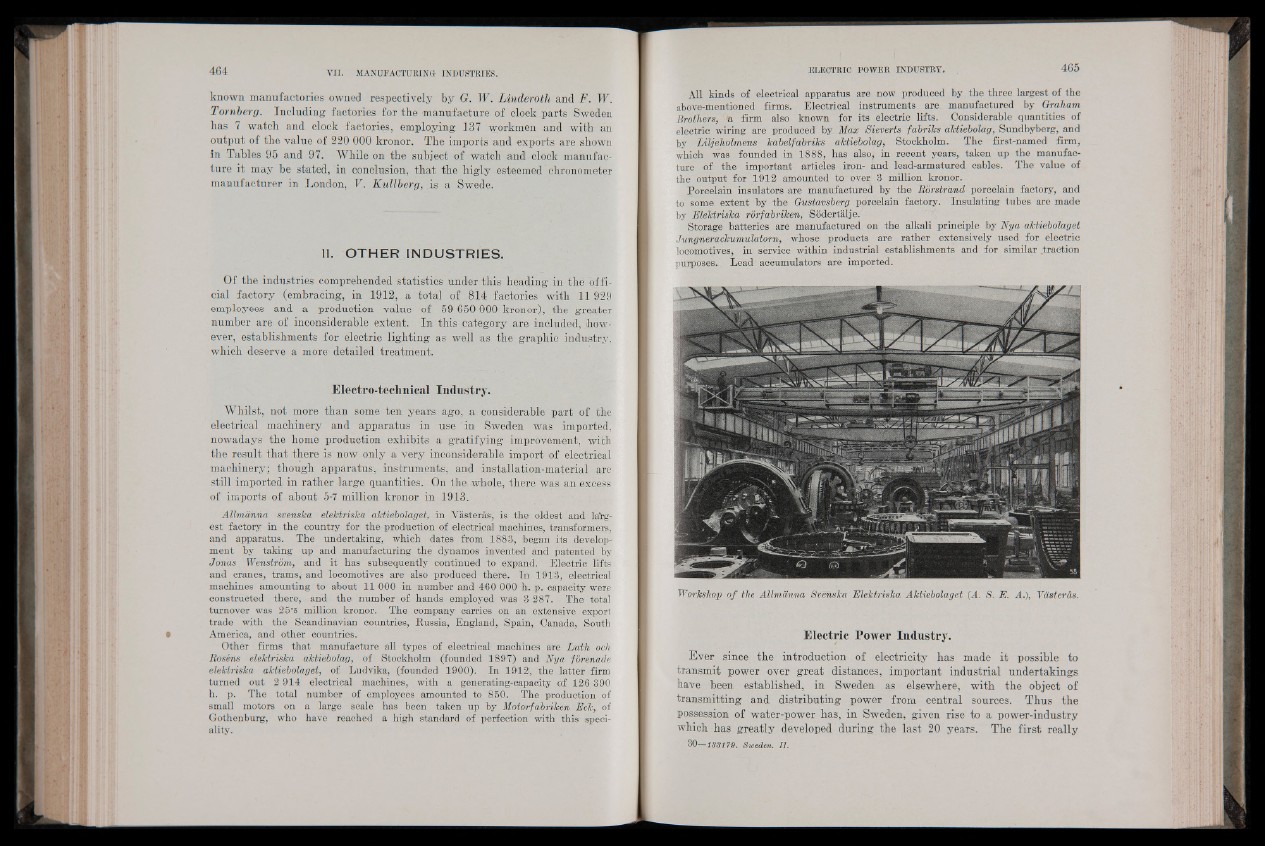
known manufactories owned respectively by G. W. Linderoth and F. W.
Tornberg. Including factories for tbe manufacture of clock parts Sweden
has 7 watch and clock factories, employing 137 workmen and with an
output of the value of 220 000 kronor. The imports and exports are shown
in Tables 95 and 97. While on the subject of watch and clock manufacture
it may be stated, in conclusion, that the higly esteemed chronometer
manufacturer in London, V. Kullberg, is a Swede.
| . OTHER INDUSTRIES.
Of the industries comprehended statistics under this heading in the official
factory (embracing, in 1912, a total of 814 factories with 11929
employees and a production value of 59 650 000 kronor), the greater
number are of inconsiderable extent. In this category are included, however,
establishments for electric lighting as well as the graphic industry,
which deserve a more detailed treatment.
Electro-technical Industry.
Whilst, not more than some ten years ago, a considerable part of the
electrical machinery and apparatus in use in Sweden was imported,
nowadays the home production exhibits a gratifying improvement, with
the result that there is now only a very inconsiderable import of electrical
machinery; though apparatus, instruments, and installation-material are
still imported in rather large quantities. On the whole, there was an excess
of imports of about 5-7 million kronor in 1913.
Allmanna soenska elektriska aktiebolaget, in Vâsterâs, is the- oldest and largest
factory in the country for the production of electrical machines, transformers,
and apparatus. The undertaking, which dates from 1883, began its development
by taking up and manufacturing thé dynamos invented and patented by
Jonas Wenstrom, and it has subsequently continued to expand. Electric lifts
and cranes, trams,- and locomotives are also produced there. In 1913, electrieal
machines amounting to about 11 000 in number and 460 000 h. p. capacity were
constructed there, and the number of hands employed was 3 287. The total
turnover was 25'6 million kronor. The company carries on an extensive export
trade with the Scandinavian countries, Russia, England, Spain, Canada, South
America, and other countries.
Other firms that manufacture all types' of electrieal machines are Luth och
Rosens elektriska aktiebolag, of Stockholm (founded 1897) and Nya fbrenade
elektriska aktiebolaget, of Ludvika, (founded 1900). In 1912, the latter firm
turned out 2 914 electrical machines, with a generating-eapaeity of 126 390
h. p. The total number of employees amounted to 850. The production of
small motors on a large scale has been taken up by Motorfabriken Eck, of
Gothenburg, who have reached a high standard of perfection with this speciality.
All kinds of electrical apparatus are now produced by the three largest of the
above-mentioned firms. Electrical instruments are manufactured by Graham
B r o th e r s , firm also known for its electric lifts. Considerable quantities of
electric wiring are produced by Max Sieverts fabriks aktiebolag, Sundbyberg, and
by Liljeholmens kabelfabriks aktiebolag, Stockholm. The first-named firm,
which was founded in 1888, has also, in recent years, taken up the manufacture
of the important articles iron- and lead-armatured cables. The value of
the output for 1912 amounted to over 3 million kronor.
Porcelain insulators are manufactured by the Rorstrand porcelain factory, and
to some extent by the Gustavsberg porcelain factory. Insulating tubes are made
by Elektriska rbrfabriken, Sodertalje.
Storage batteries are manufactured on the alkali principle by Nya aktiebolaget
Jungnerackumulatorn, whose products are rather extensively used for electric
locomotives, in service within industrial establishments and for similar Traction
purposes. Lead accumulators are imported.
Workshop o f the Allmänna Svenska Elektriska Aktiebolaget (A . S. E. A.), Vâsterâs.
Electric Power Industry.
Ever since the introduction of electricity has made it possible to
transmit power over great distances, important industrial undertakings
have been, established, in Sweden as elsewhere, with the object of
transmitting and distributing power from central sources. Thus the
possession of water-power has, in Sweden, given rise to a power-industry
which has greatly developed during the last 20 years. The first really
30—133179. Sweden. II.